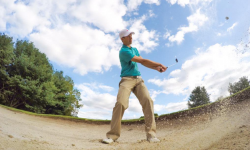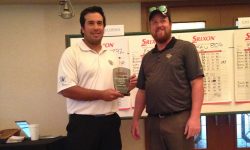We can hit every shot perfect on the range before a round and go out on the course and play the worst round of our life. Golf is funny like that. As golfers, most of us on any given day would take playing a round over spending hours on the practice tee, but in the right circumstances the course can become your practice field. As young golfers - we are often able to golf at all hours of the day – on of the perks of still being in college and dodging the real world for a few more preciorius years. As such – we often play late in the day when there are few golfers on the course. The next time you are out on the course – seemingly all alone – get some practice in. I don't mean to suggest that the course takes the place of a range or practice green for truly honing skills, but on course practice can offer opportunities that most practice facilities can't. The course is where we score and it is where we can really build confidence for when we go out in competitive play.
When the course is empty or you're stuck behind a slow group, you can get some great practice in. One way to do this is short-game practice. The course can offer greenside lies and short game shots that you will only see on the course and that are difficult to practice on the range. While you have the time, instead of waiting on the tee and breaking your rhythm, throw a few balls down around the green and hit them as if they were your approach shot. This means going through your pre-shot routine and working on that feel around the greens. I see so many golfers just throw balls down around the green and slap them around. This can breed bad habits and kinks in your swing. Try to put yourself in the mindset of getting up and down for par. They more you do it, the more confidence you will get in your short game.
If you're ever in a situation where there are no golfers behind you, you can turn a round into a great practice situation. Hit a shot or two from awkward lies and stances. Almost all practice ranges are completely flat - only a few have areas where you can practice hitting side hill, downhill, and uphill lies. The course, however, offers these shots in abundance. The ball reacts differently in these situations, and learning how to play them is vital to shooting low scores. Just remember that hitting shots like this can tear up the course so use discretion and remember to fill those divots!
One of the best ways to practice out on the course is - as long as it is not disruptive to other golfers - play two balls and always play the worst shot of the two. If you pound your first drive right down the middle of the fairway, and you hit your second drive into a fairway bunker - play two from the sand shot and pick up the other one. Most competitive players know how to play shots out of the middle of the fairway - but what separates high and low scores is saving pars from adversity. Doing this helps you become more familiar with awkward shots, shots that most practice ranges can’t support. The next time you're out on the course practicing - don't be afraid to play your worst ball. Put yourself in unfamiliar situations so they become familiar when you are playing for score. When you go to play in your next competitive round, you won't be intimidated or nervous if you hit a wayward shot because you would have hit that shot before. It is great practice both physically and mentally.
Practicing on the course can be very tricky - you must always take care to not disturb other golfers or tear up the course. We have all been in situations, however, where we have found that we are the only ones on the course. The next time you don't see any other golfers for miles, throw a few down and get some great practice out of your round.
**Bob Bonney is a senior at William & Mary and president of the club golf team




